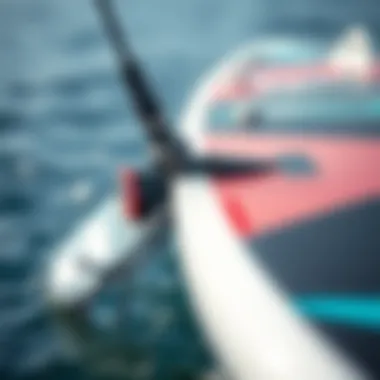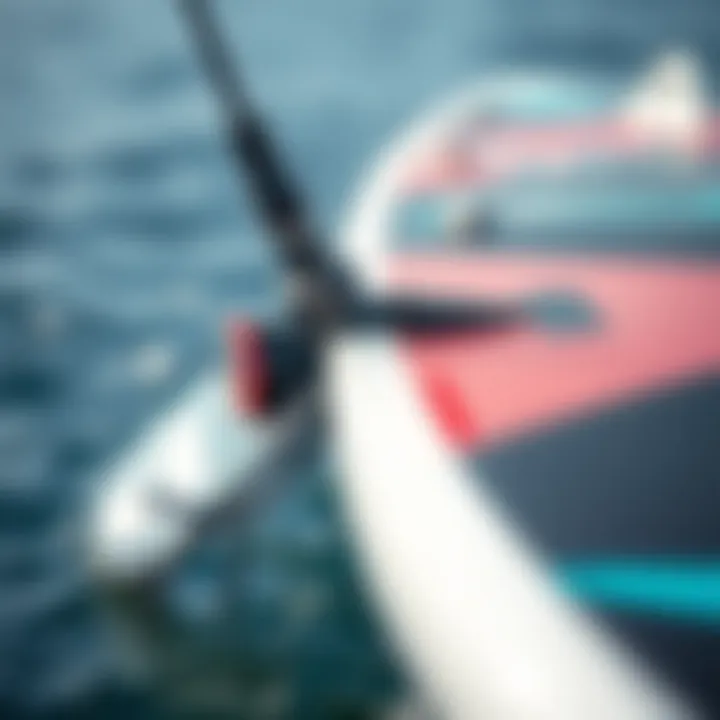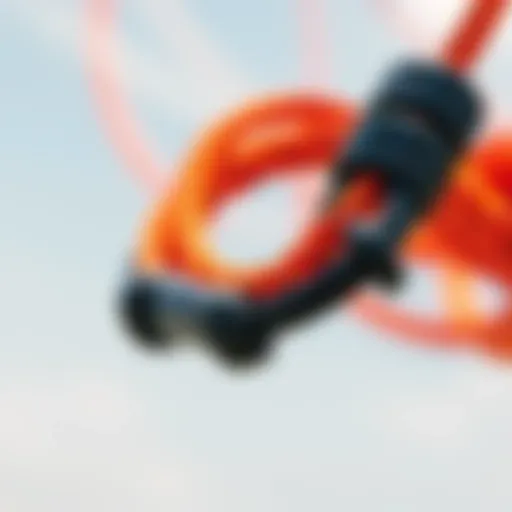Exploring Hydrofoil Surfboards: A Complete Guide


Intro
The world of surfing is constantly evolving, embracing new technologies that enhance not just performance but also the pure joy of riding the waves. Among these innovations, the hydrofoil surfboard has emerged as one of the most fascinating advancements. Unlike traditional surfboards that sit flat on the water's surface, hydrofoil boards lift above the water, allowing riders to glide effortlessly over waves. This unique design can feel like flying, transforming the experience of surfing into something otherworldly.
In this guide, we'll dissect everything you need to know about hydrofoil surfboards, from the mechanics that make them tick to practical tips to enhance your ride. So, whether you’re a kiteboarding novice or a seasoned wave rider looking to elevate your game, there’s something here for everyone. We will delve into how hydrofoils work, the essential gear needed to get started, safety practices, and techniques for honing your skills. Let's dive into the deep end of this captivating surfboard technology.
Preface to Hydrofoil Surfboards
Hydrofoil surfboards represent a fascinating intersection of design, technology, and thrill-seeking, elevating the surfing experience into a new realm. As adventurers look to push boundaries, understanding hydrofoils becomes not just beneficial but essential for anyone serious about the sport. These boards allow surfers to glide above the water's surface, reducing drag and enhancing speed while providing a unique sensation that feels almost like flying. This introduction sets the stage for exploring not just how these boards function, but also the transformative impact they have on riding dynamics.
Definition and Overview of Hydrofoils
A hydrofoil is essentially a wing-like structure attached beneath the board, which, when in motion, lifts the board above the water. This design minimizes water friction, enabling surfers to move swiftly and smoothly across swells without the resistance typical of traditional surfing methods. The main components of a hydrofoil include the mast, wings, and fuselage.
The mast anchors the foil to the board, suspending it underwater, while the wings generate lift as the board achieves speed. The fuselage connects the wings to the mast, creating a stable platform that keeps everything intact. As simple as it sounds, the engineering behind hydrofoils is quite intricate, designed to provide a balance between lift and drag, crucial for an optimal surfing experience.
Historical Context and Evolution
Hydrofoils aren't just a recent fad; their origins can be traced back to the early 20th century. The first hydrofoil was developed in 1906 by Italian engineer Enrico Forlanini, who created a prototype boat using the same principles now found in surfboards. Throughout the decades, various types of watercraft have utilized foil technology, mainly in racing and military applications. However, it wasn't until the turn of the century that surfboard hydrofoils began to gain traction, largely due to the advent of lightweight materials and advances in aerodynamics.
Early adopters of hydrofoil surfing faced a steep learning curve but quickly discovered the exhilaration that hydrofoils offered. The infusion of kiteboarding culture also played a significant role, enabling a broader audience to explore this innovation. Now, thanks to modern manufacturing techniques and evolving design philosophies, hydrofoil surfboards are accessible to everyone—from seasoned professionals eager to improve their performances to beginners ready to experience aquatic levitation.
Design Elements of Hydrofoil Surfboards
Diving into the design elements of hydrofoil surfboards is crucial for grasping how they enhance the surfing experience. These boards provide a unique blend of technology and craftsmanship that can drastically influence performance. Understanding the specific attributes that make up hydrofoil surfboards helps riders, both novice and experienced, to make informed choices tailored to their needs.
Understanding the Hydrofoil Structure
The hydrofoil itself consists of a long mast connected to a wing that sits beneath the water. This structure serves a vital function: it lifts the board above the water's surface as the surfer gains speed. The deeper the hydrofoil is submerged, the more efficient it becomes at generating lift. The wing's aspect ratio, curvature, and surface area play a significant role in how it interacts with water.
A low aspect ratio wing is generally more stable at lower speeds, making it a favorable choice for beginners. On the other hand, high aspect ratio wings excel at higher speeds with increased efficiency, though they can be trickier to control. This balance of attributes indicates the importance of the hydrofoil’s design. The mastery of these elements will undoubtedly lead to better tackling of waves, riding more smoothly, and enhancing overall performance.
Materials Used in Construction
The materials selected for hydrofoil surfboards are just as important as their structure. Most modern hydrofoils utilize a combination of carbon fiber, aluminum, and plastic to achieve the ideal balance between strength and lightweight properties. Carbon fiber is especially prized for its stiffness and low weight, giving boards the reactive responsiveness that seasoned riders crave. Aluminum, while heavier, offers durability, especially useful for those who may frequently encounter rocky shorelines or harsher environments. Meanwhile, high-density plastics tend to be used for the molded parts that do not require the same level of precision, keeping costs lower without sacrificing too much on quality.
Some key materials and their roles include:
- Carbon Fiber: Lightweight and strong, enhances performance.
- Aluminum: Provides durability, resistant to corrosion.
- Plastic: Cost-effective, used for non-critical components.
Selecting the right materials can make a huge difference in the longevity and functionality of a hydrofoil.
Shape and Size Considerations
Shape and size directly affect the hydrofoil's performance, highlighting the individuality of each surfer's style. The size of the wing and the dimensions of the board determine not just speed but also stability and maneuverability. Larger wings generate more lift, which can be beneficial for heavier riders or those who want to cruise with ease on flatter water. Conversely, a smaller wing allows for sharper turns and tricks, catering to more experienced riders looking to push their limits.
Considerations for shape and size include:
- Wing Size: Larger surfaces assist in lift; smaller allow for agile maneuvers.
- Board Length: Typically, longer boards provide stability, while shorter boards enhance responsiveness.
- Thickness: Thicker boards may float better but can create drag, affecting speed.
Choosing the right combination of size and shape is critical in ensuring the rider achieves optimal performance, aligning with personal goals and local conditions.
"In hydrofoil surfing, design is not just a set of choices; it's a commitment to enhancing the ride."
Understanding these design elements offers a foundation for both functional and aesthetic considerations in hydrofoil surfing. As riders become more familiar with their boards, they can start to see how personal preferences can be matched with the technological aspects of their equipment.
Mechanics of Hydrofoils
Understanding the mechanics of hydrofoils is crucial for anyone wanting to navigate the waters gracefully with a hydrofoil surfboard. This section will clarify how hydrofoils operate, emphasizing the intricate dance of physics and design that allows surfers to glide over the surface of the water with minimal resistance. The mechanics behind these devices not only enhance the overall experience but also elevate performance to astonishing heights—literally.
How Hydrofoils Work
Hydrofols are not just magical devices; they rely on fundamental principles of physics to enable surfers to rise above the water. In essence, the hydrofoil consists of a wing-like structure submerged underwater. As the surfboard moves forward, water flows over and under the foil. This movement generates lift thanks to Bernoulli’s principle, which states that an increase in the speed of a fluid occurs simultaneously with a decrease in pressure. This allows the hydrofoil to lift the board and rider above the surface, reducing drag and creating a smoother ride in varying water conditions.
The angle of attack, or the angle at which the hydrofoil meets the oncoming water, plays a significant role in its effectiveness. If the angle is too steep, the foil can experience stall, causing a sudden drop back to the water. Conversely, a flatter angle can produce less lift, making it hard to rise. Hence, mastering the angles is essential. It’s a delicate balance between maintaining speed and adjusting the foil's position within the water.


Additionally, the design of the hydrofoil can impact its performance. For instance, a larger mast offers higher lift but can be harder to control, especially in choppy waters. Understanding these mechanics will not only allow for a more enjoyable surfing experience but also assist in fine-tuning personal technique for enhanced performance.
Buoyancy and Lift Generation
Buoyancy is perhaps the unsung hero of hydrofoils. When a surfboard with a hydrofoil takes to the water, several forces come into play. Simply put, buoyancy is the upward force that counters gravity. Hydrofoils capitalize on this by generating lift through the shape and angle of the foil submerged in the water. The goal is to produce enough lift to counteract the surfer’s weight and the board’s mass, resulting in a thrillsing ride above the water's surface.
The lift generated by the hydrofoil can increase dramatically by adjusting the speed of the surfboard. The faster the speed, the quicker the airfoil can create lift due to increased water flow. This generates a sensation akin to flying that many riders find exhilarating. In contrast, slow speeds can lead to inefficient lift and difficulty in maintaining altitude.
"The key to mastering hydrofoil surfing lies in understanding how to manipulate buoyancy and lift effectively, allowing riders to conquer diverse water conditions and embrace a unique surfing experience.”
To optimize buoyancy, riders often experiment with different mast heights, board sizes, and foil shapes. Each has a significant role in how lift is generated and can lead to remarkable differences in performance based on rider style and conditions. With practice, balancing these elements can become second nature, unlocking a new level of freedom and satisfaction on the water.
Benefits of Using Hydrofoil Surfboards
The world of hydrofoil surfing offers numerous advantages that enhance the riding experience, both for seasoned pros and those just getting their feet wet. The benefits of using hydrofoil surfboards extend beyond mere novelty; they transform the way surfers engage with the ocean. Whether it’s the thrill of gliding above the waves or the efficiency of movement, hydrofoils pack a punch in performance and capability.
Enhanced Performance and Speed
When it comes to performance, hydrofoil surfboards shine brighter than many traditional boards. The hydrofoil itself allows the board to lift above the water at speeds that would usually be unachievable with typical surfboards. Riders often notice an immediate boost in their speed. This results from the way hydrofoils generate lift as water flows over the wings of the foil. The board essentially 'flies' above the surface, granting riders a unique experience as they skim over the water.
- Accelerated Speed: The ability to reach higher speeds with less energy makes hydrofoils appealing to many surfers. Unlike a traditional board that relies on paddling against the waves, hydrofoils can use the energy of the water to propel themselves, making it easier to catch waves and maintain momentum.
- Wave Utilization: Surfers can ride smaller waves that would typically be considered unrideable, maximizing the conditions that can be surfed. This makes hydrofoiling particularly advantageous in areas where the surf may not be consistently powerful.
- Agility and Maneuverability: The lift generated allows for sharper turns and highly agile riding, giving surfers freedom to perform tricks that previously required more experience or stronger waves.
Thus, the performance edge provided by hydrofoils elevates the overall experience, transforming every surf session into a potent blend of thrill and efficiency.
Reduced Drag and Resistance
One of the standout attributes of hydrofoils is their ability to significantly reduce drag and resistance, thus optimizing speed and stability. For anyone who has felt the frustrating pull of a wave against their board, this is a game-changer. Here’s why:
- Fluid Dynamics: Unlike traditional boards that create friction with the water surface, hydrofoils minimize contact. This keeps the board streamlined and allows it to slice through the water with ease. Less water resistance means less energy expenditure— so surfers can ride longer and stronger.
- Smoother Ride: The lift generated by hydrofoils not only enhances speed but also allows for a smoother ride over choppy surfaces. Riders no longer experience the typical jarring sensation that larger waves or bumps may usually create.
- Energy Efficiency: With reduced drag, hydrofoils can conserve energy over longer sessions. Surfers find themselves able to maintain speed with minimal effort, leaving them with more stamina for tricks and maneuvers.
“Hydrofoiling isn’t just about cutting through waves; it’s about finding a new rhythm with the ocean.”
In summation, the benefits of using hydrofoil surfboards are manifold. Enhanced performance, reduced drag, and unmatched speed make these boards an appealing choice for anyone keen on exploring new frontiers in surfing. The marriage of cutting-edge technology with the raw power of the ocean creates an exhilarating experience that invites surfers to push their limits while experiencing the waves like never before.
Getting Started with Hydrofoil Surfing
Starting your journey in hydrofoil surfing can be both exhilarating and daunting. This section focuses on the fundamental aspects that newcomers should grasp before they hit the water. Gaining an understanding of the unique dynamics and requirements of hydrofoil boards is crucial for an enjoyable experience. Transitioning from traditional surfing to hydrofoil surfing involves not only a shift in technique but also an awareness of the necessary equipment and safety practices.
Choosing the Right Hydrofoil Board
When it comes to selecting the ideal hydrofoil board, preferences can vary widely based on skill level, intended use, and wind or water conditions. Hydrofoil boards broadly fall into various categories, including beginner-friendly models and more advanced options for seasoned surfers. Beginners may want to consider a board that offers wider stability to help facilitate easier takeoffs and balance.
Here are a few important factors to consider when making your choice:
- Board Size: A larger board typically offers more buoyancy and stability, invaluable for those just starting out.
- Shape: Boards with a flatter bottom can provide easier takeoff, while those with more pronounced curves can enhance maneuverability once you feel comfortable.
- Fin Configuration: A setup with a small fin allows for smoother transitions into hydrofoiling but may not support advanced tricks initially.
Choosing a board aligned with your skill set can provide the confidence to explore newfound abilities without the struggle of control complications.
Essential Gear and Equipment
To embark on hydrofoil surfing, having the right gear is indispensable. The equipment required extends beyond just the hydrofoil board. Here’s a rundown of essential items:
- Hydrofoil Kit: This includes the mast, wings, and fuselage, all of which contribute to lift and stability.
- Wetsuit: Depending on your location, a wetsuit may be needed to keep warm and safe from colder waters.
- Leash: A reliable leash ensures you stay connected to your board, a safety feature critical during falls.
- Helmet: Protective headgear can prevent injuries while learning.
- Life Jacket: If you’re not a strong swimmer, a life jacket is a wise choice, especially in unfamiliar waters.
Collectively, every piece of gear is crucial in ensuring safety and enjoyment during your hydrofoil adventures.
Basic Techniques for Beginners
When it comes to mastering hydrofoil surfing, practice is key. Here are a few fundamental techniques that can set the groundwork for your success:
- Balancing: Start by getting comfortable with the board on flat water, adjusting your weight back and forth to find the balance point.
- Paddling: Using your arms to paddle can help you gain momentum. It’s best to start this on calm days where winds or waves are milder.
- Knees Up: Once on the board, keep your knees bent. This posture helps absorb the board’s movements and keeps you stable.
- Engaging the Foil: As you gather speed, shift your weight back slightly, allowing the hydrofoil to lift the board above water. This feeling of floating might take some getting used to but is undoubtedly rewarding.
Practicing these basic techniques gradually will pave the way for more advanced maneuvers down the line. Such groundwork allows enthusiasts to build their skills steadily without rushing into trickier waters prematurely.
Regular practice and patience are the chalkmarks of mastering hydrofoil surfing. Embrace learning at your own pace.”
By concentrating on the elements here, you’ve already laid a solid foundation to ensure that your foray into hydrofoil surfing is both rewarding and enjoyable. Becoming well-acquainted with the essentials not only enhances performance but also promotes safety as you delve deeper into this innovative surfing domain.


For those looking to dive deeper into hydrofoiling and find a wider community of enthusiasts,
Surf Foil Wiki could be a good resource.
Connecting with local surf schools that offer lessons could provide invaluable hands-on guidance to further bolster your skills.
Safety Guidelines for Hydrofoil Surfing
Safety should always sit front and center when it comes to hydrofoil surfing. While it offers a unique thrill and breathtaking experience gliding above the water, it also presents its own set of challenges and risks. Understanding and adhering to certain safety guidelines is crucial for ensuring that riders can enjoy their time on the water while minimizing the chances of accidents. This segment will explore essential pre-surfing checks, along with the importance of situational awareness for all hydrofoil enthusiasts.
Pre-Surfing Safety Checks
Before stepping onto your board and riding the waves, conducting thorough pre-surfing safety checks is essential. Here are some vital aspects to consider:
- Inspect the Hydrofoil Equipment: Check for any damage or wear on the surfboard and hydrofoil components. Look for any signs of cracks, loose screws, or other potential hazards.
- Properly Secure Your Foil: Ensure that the hydrofoil is tightly fastened to the board. If it's loose, it can shift unexpectedly while riding, leading to a potential wipeout.
- Life Jacket and Leashes: A well-fitting life jacket is not just advisable; it's sometimes legally required in certain areas. Also, a properly attached leash can prevent your board from drifting away if you fall.
- Strong Safety Awareness: Always make sure to alert a buddy before you head out. It’s not just for your own safety, but it also allows others to be aware of your presence in the water, especially if visibility is low.
A thorough pre-surfing checklist can greatly enhance your enjoyment on the water and keep dangers to a minimum. Always take the time to check these key areas.
Awareness of Surroundings
Being aware of your surroundings is an aspect that is often underestimated. Hydrofoiling occurs in dynamic environments, so it's imperative to stay vigilant. Here’s what you need to look out for:
- Other Water Users: Be conscious of other people in the water, whether they are surfers, swimmers, or boaters. Collisions can happen quickly, and sometimes the more significant risk can come from other riders.
- Obstacles and Hazards: Keep an eye out for submerged rocks, coral reefs, or any other natural hazards. These can create dangerous situations if you’re unaware of them.
- Changing Weather Conditions: Weather can turn on a dime. Stay informed about the local forecast, and always be ready for sudden changes like wind shifts or rough waves that could impact your safety.
- Tidal Patterns and Currents: Understanding local tidal patterns and currents can provide valuable insights into where it's more safe to surf and where it’s less advisable.
Being aware isn’t just about spotting dangers—it's also about appreciating the overall environment. Enjoy the beauty around you, but don’t let your guard down.
By following these safety guidelines, hydrofoil surfers can significantly enhance their experience while ensuring they remain safe. Always remember that safety shouldn’t be an afterthought; it’s a fundamental part of this exhilarating sport.
Maintenance and Care for Hydrofoil Surfboards
Taking care of your hydrofoil surfboard is crucial—not just for longevity, but also for ensuring optimal performance while you're out riding the waves. Just like any other piece of equipment, proper maintenance can make a world of difference. Hydrofoils, with their unique design and engineering, require specific attention to keep them functioning smoothly.
Cleaning and Storing Your Equipment
After a day of surfing, it might be tempting to toss your surfboard in the garage and forget it until your next adventure. However, neglecting maintenance can lead to wear and tear, a fact all too familiar to seasoned surfers.
First off, it’s wise to rinse your hydrofoil surfboard with fresh water after each session. Saltwater can be quite corrosive; leaving it on your board can diminish the integrity of both the board and the hydrofoil itself. Here’s a step-by-step approach:
- Rinse off the board: Use a hose or a bucket of fresh water to wash away the salt and sand. Pay special attention to the area around the foil, as debris can accumulate and cause issues over time.
- Dry the board: After rinsing, throw a towel on it to dry. Leaving it wet may lead to mold and mildew forming on certain materials.
- Store in a cool, dry place: Prolonged exposure to sun or extreme temperatures can warp the shape of your surfboard. Consider using a board bag that offers UV protection.
To further enhance your board’s longevity, keep your hydrofoil surfboard off the ground if possible. Elevating it reduces the risk of scratches or dents.
Regular Inspections and Repairs
Taking the time to inspect your hydrofoil regularly isn’t just a suggestion—it’s a necessity if you want to maintain peak performance and safety. Inspections should be a routine part of your pre-surf ritual. Here are some fundamental checks to integrate:
- Foil connection: Ensure that the connections between the hydrofoil and the board are tight. Any give in the connections can impact the riding experience and even lead to accidents.
- Check for damage: Look for cracks or chips on the board and the hydrofoil foil itself. Any damage found should be addressed promptly; even small issues can develop into larger ones if left unattended.
- Inspect the hardware: Screws and bolts can loosen over time. Check these elements regularly, re-tightening them as needed.
In terms of repairs, addressing small issues immediately prevents them from growing into major repairs down the line. If you notice any significant damage, take your board to a professional repair service specializing in surfboards and hydrofoils for a thorough checkup.
"An ounce of prevention is worth a pound of cure"—this old saying has never been truer than for hydrofoiling enthusiasts. Regular cleaning and inspections can save you from costly repairs in the future.
By committing to proper maintenance and care, you can enjoy many great rides on your hydrofoil surfboard, ensuring both adventure and safety go hand in hand while you explore the waters.
Advanced Techniques in Hydrofoil Surfing
Advanced techniques in hydrofoil surfing often set apart the casual rider from the seasoned pro. Mastery of these techniques not only enhances the thrill of the ride but also adds an element of sophistication to your performance. Understanding how to carve, turn, jump, and perform tricks can significantly elevate your hydrofoiling experience, opening avenues for creativity and skill that are unique to this exhilarating sport. Here, we delve deeper into two of the fundamental advanced techniques: carving and turning, and jumping and tricks.
Carving and Turning
Carving and turning are vital skills that can distinguish an expert hydrofoil surfer. When you're on a hydrofoil, the ability to execute smooth, controlled turns can dramatically transform your surfing style. The sensation of gliding above the water, effortlessly maneuvering through different waves, feels simply spectacular.
- Importance of Weight Shift: The key to effective carving is weight distribution. Shifting your weight towards your toes or heels is essential for initiating a turn. Proper weight management can enhance stability and control, allowing for more fluid transitions.
- Wave Interaction: Riding the waves introduces unique dynamics to surfing. Understanding how to utilize the wave’s energy is crucial. While carving, remember that the steeper the wave face, the sharper your turn can be.
- Use of Fins: Hydrofoil boards generally come with multiple fin configurations. Adjusting your fins not only impacts performance but can also aid in improving your carving techniques. Some fins offer a tighter turning radius, which is great for aggressive maneuvers.
"Mastering the turns not only makes for better control but also opens doors to advanced tricks later on."
Practicing on flat water before hitting the waves can help develop skills without the added challenge of wave dynamics. This way, you can focus on the muscle memory required for tight turns and pivots.
Jumping and Tricks


Jumping and performing tricks on a hydrofoil surfboard is one of the most exhilarating aspects. Taking your riding to heights—literally—requires practice and finesse.
- Approach Speed: When you're gearing up to jump, it’s crucial to maintain appropriate speed. Too fast can lead to losing control, while too slow means limited lift off. Finding that sweet spot often requires practice in various conditions.
- Pop Technique: The initial lift during a jump comes from 'popping' off the tail of the board. Timing your pop with a slight shift in weight can send you into the air more smoothly. Focus on pulling your knees up toward your chest to maintain balance while airborne.
- Spotting Your Landing: As you're in the air, keep your eyes on where you intend to land. This is vital for aligning your board and preparing for a smooth touchdown. Practicing different heights and rotations can enhance your aerial skills.
Both carving and jumping carry their risks. Therefore, engaging in these advanced techniques should always be accompanied by wearing protective gear and employing sound judgment regarding your surroundings.
As the sport continues to grow, innovation brings forth even more exciting opportunities. The techniques you master today can evolve into groundbreaking tricks that will excite and inspire the hydrofoil surfing community in the future. The essence is not just in the action but in the fluidity and style you bring to the water.
Exploring Popular Hydrofoil Surfing Destinations
Hydrofoil surfing has the potential to transform your experience on the water, offering unmatched speed and a thrilling sensation of flying above the waves. However, the location you choose to navigate can vastly influence your experience. Understanding the top spots for hydrofoil surfing not only enhances your ride but also ensures safer and more enjoyable sessions.
Top Locations for Hydrofoil Surfing
Choosing the right location is pivotal. Each spot comes with unique attributes, which can significantly affect your hydrofoil surfing experience. Here’s a rundown of popular destinations:
- Maui, Hawaii: Known as a mecca for water sports, Maui offers consistent winds and clear waters. Locations like Kanaha Beach are particularly favored, providing ample space and suitable conditions for hydrofoiling.
- Lake Garda, Italy: This stunning lake in northern Italy is famous for its afternoon winds, known as the Ora. The scenery is breathtaking, making it ideal not just for hydrofoil surfing but also for enjoying the picturesque landscape.
- Cape Town, South Africa: With its white sandy beaches and steady winds, Cape Town has gained a reputation among surf enthusiasts. Spots like Kite Beach cater well to hydrofoilers of different skill levels.
- Gulf Coast, Florida: The sheltered waters and warmth of the Gulf Coast makes it perfect for year-round hydrofoiling. The shallow waters offer a unique experience, especially for beginners.
These destinations not only offer thrilling waters but also have a vibrant community of water sports enthusiasts. Finding fellow riders could lead to tips and tricks that enhance your skills.
Environmental Conditions to Consider
While these locations are appealing, environmental conditions can dictate the comfort and safety of your hydrofoil surfing session. Here are some critical factors to consider:
- Water Depth: Hydrofoiling requires deeper waters to avoid potential collisions with obstacles. Shallow areas can be trickier and may pose a risk for inexperienced riders.
- Wind Direction and Speed: Different locations have varying wind conditions, which can either aid or hinder your performance. It's crucial to check local forecasts before heading out.
- Tides: Tidal changes can influence water levels and currents. Understanding these patterns is vital for predicting safety hazards and optimizing your ride conditions.
- Weather Conditions: Clear skies and calm waters can enhance the joy of hydrofoiling. Stormy weather, on the other hand, can quickly turn a fun session into a hazardous adventure.
"Finding the right spot with favorable conditions is like discovering a new playground where freedom knows no bounds. "
In summary, choosing the right destination not only enhances your experience but also plays a significant role in safety while hydrofoil surfing. Whether you’re a seasoned rider or just starting, being informed about the locations and environmental factors will help elevate your adventure.
The Environmental Impact of Hydrofoil Surfing
The growing popularity of hydrofoil surfing calls for an examination of its environmental impact. As surfers ride the waves, there’s more than just thrill and adventure at play — there's a responsibility to our natural waters. Understanding how hydrofoil surfboards affect the ocean can help enthusiasts navigate this sport with a conscious mind, making decisions that prioritize sustainability and preservation of marine ecosystems.
Sustainability in Surfboard Production
When we speak of sustainability in the context of surfboards, it’s vital to look at the materials and processes used in their production. Traditional surfboards often rely on polyurethane foam and fiberglass, both of which can be harmful to the environment.
Innovations have emerged, allowing for greener alternatives.
- Epoxy Resins: Unlike conventional materials, epoxy resins are known for being less toxic and more durable. This means they’re not just kinder to the planet; they also last longer, reducing the frequency of replacements.
- Natural Materials: Manufacturers are increasingly turning to sustainable resources such as bamboo or recycled materials. This shift not only lowers the carbon footprint but also brings unique designs to the market.
- Local Sourcing: Companies focusing on local production not only bolster regional economies but also minimize shipping emissions, lending a hand to the green cause.
"The future of surfing lies not just in the waves we ride but in how we ride them, with respect for the earth beneath our feet."
Practicing Responsible Surfing
Responsible surfing goes hand in hand with environmental stewardship. As hydrofoil surfing increases its footprint on the waters, there are several practices enthusiasts can adopt to mitigate harmful effects.
- Awareness of Marine Life: Always keep an eye out for wildlife, especially in popular surf spots where marine animals may reside. A little vigilance goes a long way in ensuring that both surfers and sea creatures can coexist.
- Leave No Trace: After your session, a quick clean-up of any trash left behind will greatly help maintain the natural beauty of the location. This simple act can inspire others and fosters a community of responsibility.
- Environmental Education: Engage in conversations about the local ecosystem. Understanding the delicate balance of marine habitats can promote better decision-making when hitting the water.
- Participation in Conservation Efforts: Join local beach clean-ups or conservation projects. Getting involved not only benefits the environment but connects the sport with a greater purpose.
In summary, while hydrofoil surfing offers an exhilarating experience, it also brings with it an obligation to protect the water we cherish. By embracing sustainable practices in production and pursuing responsible surfing habits, enthusiasts can ensure that hydrofoil surfing continues to thrive without compromising the health of our oceans.
Future Trends in Hydrofoil Surfing
The world of hydrofoil surfing is continuously evolving, and understanding the future trends in this field is essential for both novices and seasoned surfers. The future of hydrofoil surfing is not just about the boards themselves but also encompasses the innovations that will shape the entire experience on the water. By exploring these upcoming trends, surfers can stay ahead of the curve, ensuring they get the most out of their time in the waves.
Technological Innovations on the Horizon
Technology in hydrofoil surfing is advancing rapidly, which opens a myriad of possibilities. We are witnessing the emergence of several key innovations that promise to change how riders interact with their watercraft. Here are a few noteworthy advancements:
- Electric Hydrofoils: There’s growing interest in electric-powered hydrofoils. These boards can self-propel, allowing riders to enjoy hydrofoil surfing even in low-wind conditions. Imagine zipping across the water without relying solely on the wind or waves!
- Smart Technologies: Integration of smart tools into hydrofoils that provide real-time data analytics. This might range from GPS tracking to performance metrics, giving riders insights into their skills and styles, allowing for improvement.
- Enhanced Materials: Future hydrofoils are likely to utilize lighter and more durable materials such as carbon fiber or advanced polymers. These materials do not only improve buoyancy and performance but also prolong the life of the equipment.
“Innovation is the key to unlocking the full potential of hydrofoil surfing, transforming how we ride the waves.”
Each of these innovations carries the potential to significantly enhance the experience. But started? Simply keep an eye out for the latest gear and technologies coming from trusted brands.
The Next Generation of Surfboards
What does the next generation of hydrofoil surfboards look like? Designers are continually pushing the limits of creativity and functionality. Here’s what to expect:
- Improved Hydrofoil Design: Expect to see hydrofoils with adjustable wings, which allow users to customize lift and drag according to conditions. This adaptability lets riders harness different environments effectively.
- Ergonomic Shapes: The design of surfboards will likely evolve into more user-friendly shapes that enhance comfort during use. This may lead to larger platforms for added stability or more pronounced curves for better maneuverability.
- Sustainable Production Practices: As the world increasingly migrates towards sustainability, future surfboards may be constructed from eco-friendly materials, ensuring that the thrill of surfing doesn’t come at the cost of our oceans.
In summary, the future trends in hydrofoil surfing are sculpting an exciting pathway for the sport. From technological innovations to new designs, the landscape is vibrant with possibilities. Keeping abreast of these trends will enhance not only personal performance but also the overall surfing experience. As the sport continues to grow, so does the opportunity for adventure seekers and sports enthusiasts to ride the waves in novel ways.



